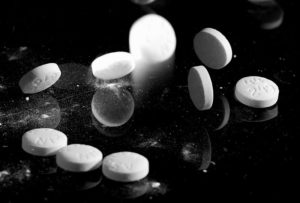Playlist
Show Playlist
Hide Playlist
Prolong Duration of Action
-
Slides 13 Chemistry Advanced Le Gresley.pdf
-
Download Lecture Overview
00:01 Another thing you can do by modifying the structure of a drug is prolong the duration of action. This is being carried out successfully for depot injections of steroids and antipsychotics and usually consists of, for example, ester derivatives, yet again. 00:16 Let’s have a look, for example, at oestradiol. So, oestradiol is shown at the bottom right hand corner here, which is a steroid, as you can clearly see from its structure and the prodrug of oestradiol is a ester of that particular cyclopentanol system in the right hand corner, as you can see. So, the prodrug of oestradiol, which is now more lipophilic, is given intramuscularly and is hydrolysed slowly, in vivo, to give the free oestradiol over a prolonged period of time. And it’s important to know that whereas when we have relatively short chain esters, they are quite prone to hydrolysis. 00:56 If we make the chains of the ester look a bit longer, such as in this case, which is a pentyl ester, the actual rate of hydrolysis is actually reduced. So, in this case, rather than, if you like, quickly clearing or making available a large amount of active drug through the actions of esterases, we can actually release it slowly as a consequence. Another example would be fluphenazine decanoate, which has a duration of four weeks and is given by oily injection. Now, I would like to come on to another subject which relates to altered derivatisation and patient compliance. Prodrugs can also be used to make a drug more acceptable to take. It is particularly important when dealing, for example, with children. So, for example, if the drug has an unpleasant taste; an example of this would be, especially in the third world, a very important antibiotic, chloramphenicol. So, clindamycin and chloramphenicol both have very bitter tastes. This can be overcome by esterifying them with a long chain fatty acid such as a palmitic acid. The palmitate ester has been found to have no bitter taste due to the reduced aqueous solubility and therefore, does not dissolve on the tongue. Palmitate esters are then rapidly hydrolysed to produce the parent drug once it’s passed through into the gastrointestinal tract. Another reason of why prodrugs are important is that they can be used or modifications can be used to prevent unpleasant side effects produced by the parent drug itself. A good example of this again relates to the inflammatory cascade, COX-1, COX-2 inhibition. An example of this would be nonsteroidal anti-inflammatory drugs or NSAIDs. NSAIDs, and aspirin falls into that category, can produce gastric irritation via direct acidic irritation and also via direct inhibition of prostaglandin production in the gastrointestinal tract. This is the problem, particularly if you are trying to use it over a long term. Prodrugs of nonsteroidal anti-inflammatory drugs such as nabumetone can cause minimal irritation; as a prodrug, they themselves are not acidic. You will see what I mean in the right hand corner here. So, nabumetone in the top right hand corner is, of itself, not acidic; it doesn’t contain a carboxylic acid group and therefore, can neither directly antagonise the amounts of prostaglandin synthase within the stomach lining nor can it directly irritate as an acid. 03:37 However, it is actively metabolised in the liver via an oxidase to the active metabolite shown in the bottom right hand corner in this particular scenario. And so, prodrugs of these NSAIDs such as nabumetone cause minimal irritation since they are themselves neither acidic nor antagonists of cyclooxygenase enzymes. As you can see in the bottom right hand corner through series of oxidation reactions, the active metabolite is produced. 04:05 So, in summary, prodrugs themselves are inactive compounds that are metabolised to the active compound in vivo using endogenous enzymes. They are used for a wide variety of different purposes such as increasing absorption, reducing side effects and improving distribution and producing a prolonged release of the active drug. Ideally, prodrugs should have improved bioavailability, more so than the parent drug, and produce non-toxic metabolites.
About the Lecture
The lecture Prolong Duration of Action by Adam Le Gresley, PhD is from the course Medical Chemistry.
Included Quiz Questions
The duration of a drug action is prolonged by which of the following?
- Structural modification
- Addition of enzyme inhibitors
- Addition of pH stabilizers
- Addition of common salt as a preservative
- Administration of a sacrificial compound along with prodrug
Which of the following is NOT true about estradiol?
- The prodrug form of estradiol gets hydrolyzed very fast. Therefore, it is unsuitable for clinical use.
- Estradiol valerate, an ester of the cyclopentanol system, is a prodrug of estradiol.
- The prodrug form of estradiol is more lipophilic than the active form.
- The intramuscularly administrated prodrug of estradiol hydrolyzes slowly and hence remains effective over longer durations of time.
- Estradiol is a steroid hormone which plays a major role in the reproductive cycle of human females.
To enhance the palatability of parent drugs, the prodrugs are prepared by which of the following?
- Esterification with long chain fatty acids like palmitic acid.
- Esterification with short chain fatty acids.
- Esterification with weak acids like acetic acid.
- Esterification with cyclic hydrocarbon molecules.
- Esterification with strong mineral acids like H2SO4.
Customer reviews
5,0 of 5 stars
| 5 Stars |
|
5 |
| 4 Stars |
|
0 |
| 3 Stars |
|
0 |
| 2 Stars |
|
0 |
| 1 Star |
|
0 |




